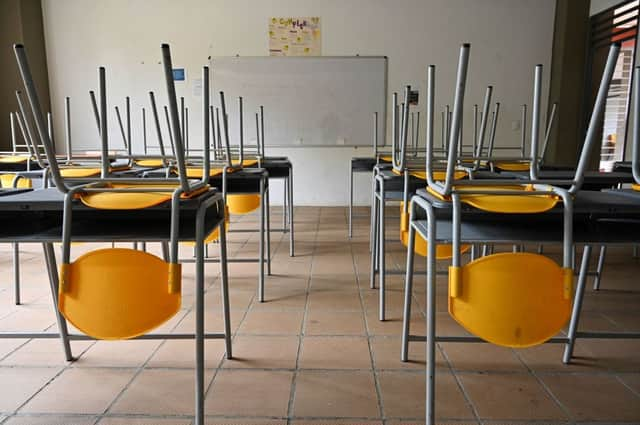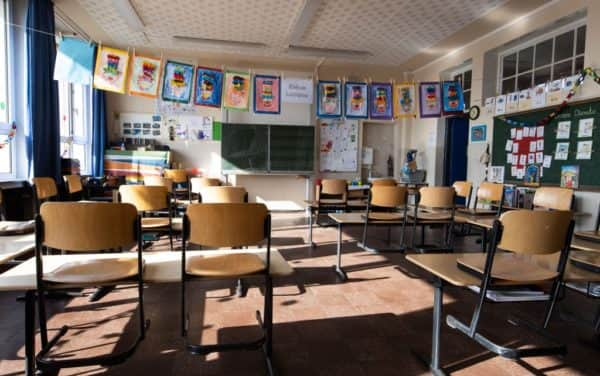Here's how new coronavirus rules could work when UK schools open


On 10 May Boris Johnson announced the Government's plan to gradually bring the UK out of lockdown, including a timeline for when schools will reopen.
Schools have been closed to all but the children of essential workers since the end of March to help guard against the coronavirus pandemic, but Johnson has pinpointed 1 June as the earliest possible date for their reopening.
That road map only applies in England for now.
Advertisement
Hide AdAdvertisement
Hide AdWales' Education Minister Kirsty Williams has said Welsh schools will not reopen on 1 June, and Scotland's First Minister Nicola Surgeon has said a return "might not be possible" by the summer holidays, which start at the end of June.
In Northern Ireland, education minister Peter Weir has said a phased return in September is most likely.
Though the Government's current anticipation is that schools in England may be able to reopen from 1 June, they note that gates will only open "provided that the five key tests set by government justify the changes at the time", including the rate of infection decreasing.
Who will be asked to return to school?
If it is safe for schools to reopen , the Government will ask that primary schools welcome back children in nursery, reception, Year 1, and Year 6.
Advertisement
Hide AdAdvertisement
Hide AdSecondary schools, sixth form and further education colleges will be asked to offer "some face-to-face support" to supplement the remote education of Year 10 and Year 12, due to take key exams next year.
"We are also asking nurseries and other early years providers, including childminders, to begin welcoming back all children," say the Government.
How will schools be different?


When 1 June rolls around, it's likely the coronavirus pandemic will be far from over, whether it's safe for schools to reopen or not.
That means the usual school experience will be have to be altered, with social distancing measures in place to try to limit the spread of the virus.
Advertisement
Hide AdAdvertisement
Hide Ad"There are important actions that children and young people, their parents and those who work with them can take during the coronavirus outbreak, to help prevent the spread of the virus," say the Government.
Their guidance is long, with suggestions of measures designed to stop the spread of Covid-19 ranging from everything from the regular washing of hands, to ensuring tissue bins are regularly emptied.
Here are some of the changes currently being advised:
- ensure that children and young people are in the same small groups at all times each day, and different groups are not mixed during the day, or on subsequent days
- ensure that the same teacher(s) and other staff are assigned to each group and, as far as possible, these stay the same during the day and on subsequent days, recognising for secondary and college settings there will be some subject specialist rotation of staff
- ensure that wherever possible children and young people use the same classroom or area of a setting throughout the day, with a thorough cleaning of the rooms at the end of the day. In schools and colleges, you may want to consider seating students at the same desk each day if they attend on consecutive days
- follow the COVID-19: cleaning of non-healthcare settings guidance
- ensure that sufficient handwashing facilities are available. Where a sink is not nearby, provide hand sanitiser in classrooms and other learning environments
- clean surfaces that children and young people are touching, such as toys, books, desks, chairs, doors, sinks, toilets, light switches, bannisters, more regularly than normal
- ensure that all adults and children:
- frequently wash their hands with soap and water for 20 seconds and dry thoroughly
- clean their hands on arrival at the setting, before and after eating, and after sneezing or coughing
- are encouraged not to touch their mouth, eyes and nose
- use a tissue or elbow to cough or sneeze and use bins for tissue waste (‘catch it, bin it, kill it’)
The above is just a snippet of the Government's official guidance.
It's easy to see why parents and teachers alike are hesitant for schools to reopen on 1 June, and why just a couple of weeks might not be enough time to get all of the above measures in place.
Will social distancing be enforceable among children?


Advertisement
Hide AdAdvertisement
Hide AdMany experts have criticised the Government's plans to push on with reopening schools, calling them premature and saying that enforcing social distancing measures among energetic pupils will be extremely difficult.
Geoff Barton, the general secretary of the Association of School and College Leaders, said: “It is not clear to us how the reintroduction of such significant numbers of pupils in primary schools can be safely managed, particularly considering that reception and Year 1 comprise very young children with whom social distancing is extremely difficult.”
Appearing on BBC Breakfast last week (15 May), the Northern Ireland Secretary, Brandon Lewis, appeared to suggest it is in fact possible.
“In terms of how this disease and this virus spreads, social distancing is important, we can do that within schools,” he said.
Advertisement
Hide AdAdvertisement
Hide AdFor the teachers and parents of younger children, this will have come as somewhat of a surprise. The minister’s words are also contradicted by the Department for Education’s own guidance to schools.
“We know that, unlike older children and adults, early years and primary age children cannot be expected to remain 2 metres apart from each other and staff,” it states.
Even with older pupils in Years 6 and above - who are capable of understanding the coronavirus and the importance of maintaining distance from one another - teachers say there will probably be near constant breaches; schools are unpredictable places, and teenagers are not famed for being placid and perfectly self-regulating individuals.
For younger primary school children though, conventional social distancing goes completely out the window.
Advertisement
Hide AdAdvertisement
Hide AdInfants do not fully understand the virus and they will not remember rules around staying apart, and many teachers point out that play and close social interaction with classmates is key to educational development at this age.
Will my child have to wear a face mask?
As the Government advises the wearing of facial coverings in situations in which social distancing might not be possible (such as on public transport, or in shops), many parents will be wondering whether they will be expected to send their children to school wearing masks or other protective equipment.
"Wearing a face covering or face mask in schools or other education settings is not recommended," say the Government.
"Face coverings (or any form of medical mask where instructed to be used for specific clinical reasons) should not be worn in any circumstance by those who may not be able to handle them as directed (for example, young children, or those with special educational needs or disabilities) as it may inadvertently increase the risk of transmission."